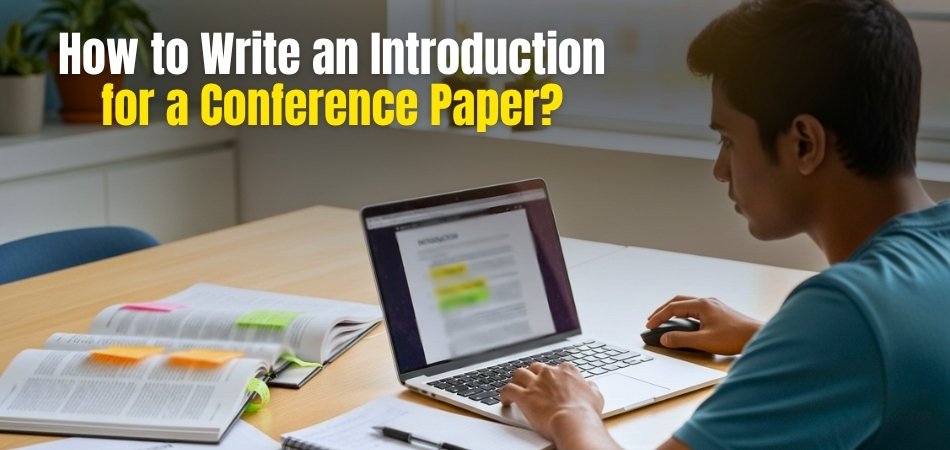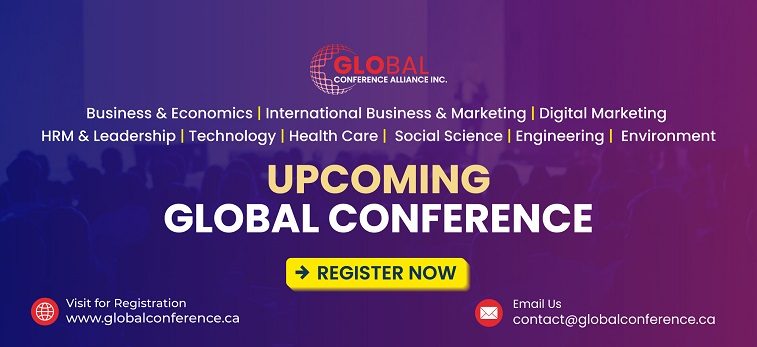It is a big step to share ideas with others by writing a conference paper. It’s the first thing people see when they want to know what your work is about. Many readers often wonder how to begin and how to make the first part strong, and that’s why you might be thinking about how to write an introduction for a conference paper.
Write a conference paper introduction by starting with a strong hook, giving a simple background, stating the problem, and showing the gap. Then explain your main idea, research questions, and outline the paper structure clearly. Use short sentences and easy words throughout.
Are you also wondering how to make your paper clear but still interesting? If yes, then keep reading this article because you will find everything you need to know about writing a great introduction for a conference paper without missing any important step.
How to Write an Introduction for a Conference Paper?
Writing the start of a conference paper can feel confusing at first. But with the right steps, you can make it clear and strong. A good introduction helps readers understand what your paper is about. Let’s walk through how to make it easy and interesting.
Catchy Opening
Think of something that will make your reader stop and think. This could be a shocking fact, a smart question, or a bold statement. It should make the reader curious to know what comes next. You want them to feel like this topic really matters. Using something simple but strong can do that very well. A great hook can make the rest easier to understand. Make sure it fits your topic and is short.
Simple Background
Readers need a little help understanding your topic better before going deeper. Give them a short and clear background so they don’t feel lost. Talk about what people already know about this topic. Try to keep it short but still helpful. Use easy words to explain any hard terms if needed. The goal is to help everyone follow along. This part builds the base for what comes next.
Explain the Gap
Many topics have some missing parts or unsolved issues in them. Pointing out that gap shows why your work is important now. Tell the reader what other papers or people haven’t done yet. Make it clear that something is missing and needs to be fixed. You are not just repeating old ideas—you are adding something new. This part shows the need for your work. It helps readers see your reason clearly.
What’s the Problem
Now it’s time to share the real problem you want to solve. Say it in a clear and simple way so it’s easy to understand. Don’t use big words or long lines that confuse people. Keep it direct and to the point with no extra details. This helps readers know exactly what your paper is about. A strong problem statement builds a good base. It tells readers what to expect later.
Your Main Idea
After showing the problem, share your main idea or solution clearly. This should be the thing you created, found, or thought about to help. Maybe it’s a new system, method, or something you built. If you’re planning for conferences, especially for global events like upcoming conferences in USA, Canada, or any other country where sharing new ideas matters, this part becomes very important. People want to hear what you are offering. So make this part short but strong.
Clear Questions
Once you share your idea, explain the questions you’re trying to answer. These can be short but must connect with your topic well. You can also add any guesses you plan to test. Questions help your paper stay focused and on track. They let readers know what you’re trying to find out. It’s like giving a list of what your paper will cover. Good questions lead to better answers later.
Easy Words
Not everyone reading your paper knows big or hard words well. Try to use simple and clear words to explain your ideas better. If you must use a hard word, just explain what it means. That way, more people can enjoy and understand your paper easily. You’re not trying to sound smart—you’re trying to be clear. Keeping it simple helps everyone follow your work. Easy words always make writing stronger.
Paper Outline
Before ending your introduction, give a short list of the paper’s parts. Tell the reader what comes next in each section simply. This helps them stay on track and not feel confused later. Just mention the key parts like your method, results, and conclusion. Don’t go too deep here—just give a quick overview. Think of it like a map of your paper. Readers feel better when they know where things are going.
Keep It Short
Even though it’s the start, the intro doesn’t need to be long. Focus only on the most important parts that help set things up. A good intro should be short, clear, and easy to read. Just five or six short parts are more than enough. Don’t add extra details that belong later. If it’s too long, readers might lose interest quickly. A short intro is often a strong intro.
This guide is here to help make your writing clear and strong. You can use these simple steps to build a great introduction. A good start keeps your reader interested from the first few lines. Keep it short, easy, and focused on your main ideas.
What Is the Purpose of the Introduction in a Conference Paper?
The introduction is the first thing people read in a conference paper. It helps set the mood and gives a quick idea of the topic. A good introduction makes people want to read more of the paper. Let’s look at what makes this part so useful and powerful.
Setting the Background
Before explaining the main topic, the paper needs to give some context. This helps readers understand where the topic fits in the real world. It’s like giving a little bit of history or story before the main idea. Without background, the topic can feel confusing or hard to follow. A good introduction makes sure readers know the basic idea first. This way, the rest of the paper becomes easier to read and understand.
Explaining the Problem
Readers need to know what issue or problem the paper will talk about. This helps them see why the paper was written in the first place. The problem shows what is missing or not working well right now. It gives the paper a reason to exist and something to focus on. A clear problem helps readers stay interested in finding out the solution. This keeps the whole paper moving in one clear direction.
Stating the Goal
Once the problem is clear, the paper should say what it hopes to do. This is the part where the writer tells the goal or aim. It helps the reader know what to expect from the rest of the paper. If the goal is missing, the paper can feel lost or confusing. A simple and clear goal makes everything feel more focused and connected. It gives the whole paper a strong and clear purpose.
Getting Attention
To make the reader interested, the paper needs an exciting start. This part can include a fun fact, a question, or a short story. It should make the reader want to keep reading and learn more. If the start is boring, people might stop reading right away. A strong beginning makes a big difference in how people feel about the paper. It sets the tone for the whole reading experience.
Giving a Quick Preview
Near the end of the introduction, the paper gives a small preview. This short part tells what the rest of the paper will cover. It does not explain everything, just the main points to expect next. This makes it easier for the reader to follow the ideas later on. Knowing what’s coming helps people stay focused while reading. It’s like a small guide that shows what the paper will talk about next.
The introduction is an important part of any conference paper. It helps readers understand and enjoy what they are about to read. A strong start makes the whole paper easier to follow. Always take time to make the introduction clear and interesting.
Key Elements to Include in a Strong Conference Paper Introduction
When someone reads a paper, the introduction is their first stop. It’s where they decide if the topic is clear and worth reading. A strong beginning makes a big difference. Let’s break down what makes an introduction really work.
Background Details
Every strong introduction begins by giving a bit of background on the topic. This helps readers understand the subject before diving into deep points. It’s like getting the basics before hearing a full story. Without background, things can feel confusing or random. A short and clear background helps set the scene, so everything else makes more sense as you read along.
Research Gap
After explaining the topic, the next part is to show what’s missing. This is where the writer points out what has not been studied or explained yet. This missing part is called the research gap. Readers need to see that the paper is solving something new. When there’s a clear gap, the paper has a purpose. It also helps readers know why the paper is worth their time.
Research Question
Once the gap is shown, the writer asks the main question that the paper will answer. This is called the research question. It helps keep everything focused and clear. Just like a good resource speaker opens a talk by clearly stating the problem and engaging the audience, your introduction should do the same in written form. A clear question tells the reader what to expect and what the paper is all about.
Clear Objectives
The goal of this part is to tell what the writer wants to do. These are called the paper’s objectives. They help the reader understand the steps the writer will take to answer the main question. With clear objectives, the paper feels organized and easy to follow. It’s like a plan that helps guide the reader through the rest of the writing without confusion or guesswork.
Paper’s Value
To wrap up the introduction, the paper should explain what it brings to the table. This part is called the paper’s contribution. It shows how the paper adds something new or useful to the topic. Maybe it gives a new idea, solves a problem, or offers a better way of doing something. A strong contribution makes the paper feel important and interesting to read.
A well-written introduction is like a small map for the full paper. It makes things easier to understand right from the beginning. When these key parts are added, the writing becomes clearer. Good starts always lead to better endings.
Common Mistakes to Avoid in a Conference Paper Introduction
Many people try to make their conference paper sound perfect from the first line. But writing too much or too little can confuse the reader. A good balance makes a stronger first impression. Let’s explore what to avoid when writing the start.
Using Vague Language
Readers can quickly lose interest if the words feel too unclear or general. It’s important to be direct so the message comes across the right way. When sentences feel unsure or have no clear point, readers stop paying attention. Saying something without really saying anything weakens the whole paper. Keeping the words simple and straight helps the introduction sound stronger and more honest right from the beginning.
Adding Too Much
Some people try to explain everything all at once in the intro. This can make the start feel heavy or confusing. One mistake is including too much technical detail from the methods section in the intro. It’s better to briefly signal the approach and save the details for when you write methodology for a conference paper in the main body. Giving too much at the start takes away from the parts meant to explain those things later.
Losing the Focus
Every introduction should follow a clear path, not jump all over the place. When the writing jumps between too many ideas, it’s hard to understand what the paper is really about. Staying focused helps readers stay with you as the paper moves forward. Each part of the introduction should help explain the topic clearly and smoothly. Losing track of that goal can make the whole paper feel off balance.
Hiding the Problem
If the main problem is not clear early in the paper, readers will be confused. The introduction should make it easy to see what the writer wants to talk about. If there’s no clear problem, the rest of the paper loses its purpose. It’s like telling a story without any reason. A strong introduction tells readers what is wrong and makes them want to know the answer.
Sounding Too Formal
Trying too hard to sound smart or formal can sometimes do the opposite. It can make the writing feel stiff and hard to understand. Readers want to feel like the writer is talking to them, not just showing off. A simple tone makes the ideas easier to follow. Writing in a friendly and clear way keeps people reading and helps them enjoy what they’re learning from the paper.
Avoiding common mistakes makes your introduction much easier to understand. A clear and simple start keeps readers interested and ready to continue. Take time to plan each part so nothing feels out of place. Small changes in the intro can make a big difference.
How Much Background Information Should You Include in an Introduction for a Conference Paper?
Writing the beginning of a paper can sometimes feel confusing or tricky. You don’t want to say too little and leave people lost. But saying too much can also make readers feel bored or tired. Let’s talk about how to get the balance just right.
Understand the Topic
Before writing anything, it helps to be clear about the topic. When you understand what the paper is about, it becomes easier to pick useful details. You can explain things simply without going off track or getting lost. A strong understanding helps you choose what to include and what to skip. That way, the background feels smooth and not too heavy or too light.
Think About Audience
Every reader is different, and not everyone knows the same stuff. Some might already know the basics, while others are reading it for the first time. So, the background should fit what most readers would need to understand. If they know less, you add a little more explanation. If they already know a lot, you can keep things short and simple.
Avoid Extra Details
It’s easy to feel like adding every fact you know, but that’s not needed. A long background full of details can take the focus away. Only share what helps the reader understand the topic better. Try to keep it short and helpful instead of long and heavy. The goal is to prepare the reader, not to teach the whole subject all at once.
Stay on Track
Each line you write should help lead into the main topic. If a sentence doesn’t help explain the subject, it doesn’t belong there. It’s important to keep your background clear and focused all the way through. Writing extra facts that don’t match the topic can confuse people. A simple and direct style helps readers stay with you the whole time.
Connect to Problem
Once readers know the basics, it’s time to guide them to the issue. The background should end by showing what the paper is really trying to solve. This makes people want to know more and understand why the paper matters. When background and problem are clearly linked, the writing feels complete. It’s the best way to move from simple facts to the paper’s big idea.
Writing background means sharing only what’s needed to understand things. Too much or too little can make it hard to follow. A strong beginning gives readers the right amount of help. When done well, it makes the rest of the paper easier.
Should You Mention Your Findings in the Conference Introduction?
You don’t need to give away all the results in the introduction. This part is meant to set the stage for what the paper is about, what problem it looks at, and what the writer hopes to figure out. If you share too much upfront, it can take away the interest and surprise from what’s to come.
Sometimes, giving a small hint or quick line about the findings is okay. This is helpful when the result is very important or surprising. But even then, it should be short and simple, not a deep explanation. The full details should still come later in the paper, where the results are properly explained.
It’s better to keep the focus on the aim of the paper and why the topic matters. Readers first need to understand what you are trying to solve or study. Once they know the reason behind the work, they will be more ready to look at the results. A clear and focused introduction makes the rest of the paper stronger and easier to follow.
Tools and Templates That Can Help You Write a Strong Introduction for a Conference Paper
Writing a good introduction becomes easier when you use the right tools. They help you plan, check, and clearly shape your ideas. With templates and outlines, your writing stays neat and focused. Below are some helpful tools to get you started.
| Tool/Template Name | Type | How It Helps |
| Basic Introduction Outline | Outline Template | Helps organize ideas into background, problem, goals, and paper structure. |
| Google Docs | Writing Tool | Easy to use, allows editing, sharing, and saving your drafts online. |
| Grammarly | Writing Assistant | Checks grammar, spelling, and sentence clarity while you write your intro. |
| Purdue OWL | Academic Resource | Offers writing guides and examples for research papers and introductions. |
| MS Word Academic Template | Document Template | Has built-in styles and sections to format your introduction neatly. |
| Hemingway Editor | Editing Tool | Highlights long, hard-to-read sentences to make writing simpler and clearer. |
| University Writing Centers | Free Templates | Many universities share free PDF or DOC templates for research paper writing. |
| Evernote or Notion | Note-Taking Tool | Lets you collect and organize key points and references before drafting. |
Using these tools saves time and avoids common writing mistakes. They guide you through each step of your introduction. Pick the ones that match your writing style best. A strong start always leads to a better paper.
How to Balance Technical Detail and Accessibility in Your Conference Paper Introduction?
Starting a conference paper can be tricky when you’re trying to sound smart but still want everyone to understand. You don’t want to make things too hard or too simple. Striking the right balance takes a bit of care. Keep reading to see how you can do it easily.
Know Your Readers
Before writing, it helps to think about who will be reading your paper. Some readers may know a lot, while others may be learning about the topic for the first time. Try to keep both types of readers in mind. Share enough detail to explain your ideas but not so much that it becomes confusing. The key is to stay clear and not go too deep too fast.
Keep It Simple
Use words that are easy to understand, even when explaining technical stuff. If you need to use special terms, give a quick and simple meaning for them. You don’t need to use big words to sound smart. A clear explanation is always better than a long one. This helps readers from different fields or with less knowledge follow along with ease.
Add Useful Details
You don’t need to explain everything, but adding the right details helps. Pick the most important parts that connect to your topic. Give short facts or examples that help explain what you mean. When you’re writing for conferences, keeping things balanced is extra helpful. This makes your work easier to understand for everyone in the room or reading your paper.
Use Short Examples
A short example can help explain a big idea without making it harder. When you give a clear example, even someone new to the topic can understand. Choose examples that are simple but still match what you’re trying to say. This helps readers connect the new information to something they already know. A good example can explain more than a full paragraph sometimes.
Avoid Too Much
It’s easy to add too much information and lose the reader. Stick to the key points and explain them well. If you add too much, the message might get lost in all the details. Make your writing light but still meaningful. Try to answer questions before readers even ask them, without going too far. Keep the flow smooth and skip anything that doesn’t really help the main idea.
Balancing detail and clarity helps your paper feel easy and smart. You can sound smart without making it hard for others to understand. Keep things clear, short, and focused on the big idea. Simple writing makes your message stronger every time.
Commonly Asked Questions
Writing the introduction of a conference paper can feel tricky, especially if it’s your first time. These frequently asked questions (FAQs) are here to help you with extra tips that weren’t covered earlier. They answer common doubts and help you feel more confident. If you’re still unsure about how to start your paper the right way, these simple answers can guide you step by step.
How Do I Know If My Introduction Is Too Long?
If your introduction feels like a full essay, it might be too long. A good introduction should only give the most important points and not go into deep detail. If you’re repeating the same idea in different words, that’s also a sign to shorten it. Try to keep it short and clear, like a quick road map of your paper.
Can I Ask a Question in the Introduction?
Yes, asking a question is a great way to grab attention. It makes the reader think and want to find the answer in your paper. But the question should match your topic and not be too confusing. Make sure you answer the question later in your paper, so the reader doesn’t feel lost.
Is It Okay to Use a Quote at the Beginning?
Using a short quote can be a strong way to start. It can show that your topic is important or interesting. Just make sure the quote comes from someone well-known or from a trusted source. Also, don’t forget to explain how the quote connects to your paper.
Should I Use First Person in My Introduction?
It depends on the rules of your teacher or the conference. Some allow “I” or “we” if you are sharing your own work. But many academic papers use the third person to sound more formal. If you’re not sure, it’s safer to avoid using the first person and just explain things clearly.
How Can I Make My Topic Sound More Interesting?
Use a strong start that connects to real-life problems or exciting facts. Think about why your topic matters and say that in a simple way. If the reader sees that your topic affects people or solves a big problem, they’ll want to read more. Don’t try to sound fancy—just make your point clear and real.
What If I Don’t Know How to Start My Introduction?
Start with a rough draft, even if it isn’t perfect. Write down your topic, the problem, and what your paper will try to solve. Once you have a few lines, you can go back and make them better. The most important thing is to get started and fix things as you go.
Can I Write the Introduction After Writing the Whole Paper?
Yes, and sometimes it’s even better that way. Once your paper is finished, you know your topic, methods, and results better. This helps you write a stronger and more focused introduction. Just make sure your introduction still comes first in the paper.
How Many Paragraphs Should My Introduction Have?
Most introductions are 2 to 4 short paragraphs. Each paragraph should have one main idea—like background, problem, and goal. Don’t make the paragraphs too long, or readers might lose interest. Keeping each part clear and short makes your writing easier to follow.
What Should I Avoid In My Introduction?
Avoid long sentences, big words, and confusing ideas. Don’t start with jokes or stories that have nothing to do with your topic. Also, don’t include results or deep methods in the introduction—save them for later. Keep your start simple, clear, and focused on your paper’s topic.
Last Words
Writing a strong start is easier when you understand what to include and why. Now you know how to explain the topic, give background, show the problem, and share your idea—all while keeping it simple. That’s how to write an introduction for a conference paper.
Before you go, remember to keep things short, use easy words, and stay focused on your main point. Practice often, trust your ideas, and be proud of your work. Good luck with your writing, and may your paper make a big impact!









